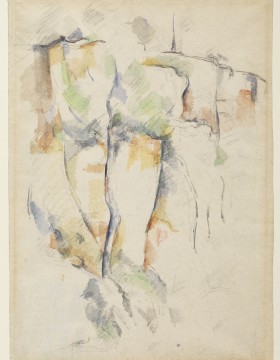Rocks at Bibémus (Rochers de Bibémus)
Provenance
Artist’s son, Paul Cézanne (1872–1947), Paris; [sold to Bernheim-Jeune, Paris, 11 Mar. 1907]; [sold to Montross Gallery, New York, 27 Mar. 1916]. [Stephan Bourgeois Gallery, New York]. Cornelius J. Sullivan (1870–1932), New York; by descent to his widow, Mary Quinn Sullivan (1877–1939), New York, sold at auction of the Sullivan Collection, American Art Association, Anderson Galleries, New York, 29 Apr.–1 May 1937, lot 61. Lionello Venturi (1885–1961), New York. [E. & A. Silberman Galleries, New York]. Colonel Samuel A. Berger; by descent to Berger Estate, sold at auction, Parke-Bernet, New York, 27 Apr. 1972, lot 56; purchased at auction by Henry Pearlman; Henry and Rose Pearlman Foundation, 1982.
Critical Perspective
This watercolor shows a detail of the ancient Bibémus quarry near Aix-en-Provence. Abandoned in the nineteenth century, the quarry offered a sprawling complex of cut and weathered rocks that bore both the recent marks of human industry and the gradual effects of wind and rain. One of Cézanne’s favorite boyhood haunts, this remote site became a favorite motif in the 1880s and ’90s.

